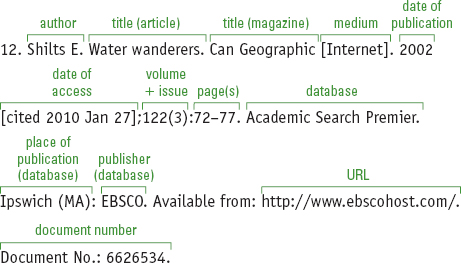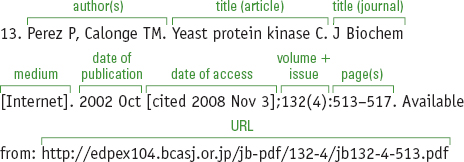Digital sources
These examples use the citation-sequence or citation-name system. To adapt them to the name-year system, delete the note number and place the revision date immediately after the author’s name.
The basic entry for most sources accessed through the Internet should include the following elements:
- Author. Give the author’s name, if available, last name first, followed by the initial(s) and a period.
- Title. For book, journal, and article titles, follow the style for print materials. For all other types of electronic material, reproduce the title that appears on the screen.
- Medium. Indicate, in brackets, that the source is not in print format by using a designation such as [Internet].
- Place of publication. The city usually should be followed by the two-letter abbreviation for the state. No state abbreviation is necessary for well-known cities such as New York, Chicago, Boston, and London or for a publisher whose location is part of its name (for example, University of Oklahoma Press). If the city is implied, put the city and state in brackets. If the city cannot be inferred, use the words place unknown in brackets.
- Publisher. For material other than journal articles from Web sites and online databases, include the individual or organization that produces or sponsors the site. If no publisher can be determined, use the words publisher unknown in brackets.
- Dates. Cite three important dates if possible: the date the publication was placed on the Internet or the copyright date; the latest date of any update or revision; and the date the publication was accessed by you.
- Page, document, volume, and issue numbers. When citing a portion of a larger work or site, list the inclusive page numbers or document numbers of the specific item being cited. For journals or journal articles, include volume and issue numbers. If exact page numbers are not available, include in brackets the approximate length in computer screens, paragraphs, or bytes: [2 screens], [10 paragraphs], [332K bytes].
- Address. Include the URL or other electronic address; use the phrase Available from: to introduce the address. Only URLs that end with a slash are followed by a period.
12. material from an online database
For the basic format for citing an article from a database, see the source map on pp. 534–35. (Because CSE does not provide guidelines for citing an article from an online database, this model has been adapted from CSE guidelines for citing an online journal article.)

13. article in an online journal

14. article in an online newspaper
14. Brody JE. Reasons, and remedies, for morning sickness. New York Times Online [Internet]. 2004 Apr 27 [cited 2009 Apr 30]. Available from: http://www.nytimes.com/2009/04/27/health/27BROD.html
15. online book
15. Patrick TS, Allison JR, Krakow GA. Protected plants of Georgia [Internet]. Social Circle (GA): Georgia Department of Natural Resources; c1995 [cited 2010 Dec 3]. Available from: http://www.georgiawildlife.com/content/displaycontent.asp?txtDocument=89&txtPage=9
To cite a portion of an online book, give the name of the part after the publication information: Chapter 6, Encouraging germination. See model 6.
16. web site

17. government web site
17. Health disparities: reducing health disparities in cancer [Internet]. Atlanta (GA): Centers for Disease Control and Prevention (US); 2010 [updated 2010 Apr 5; cited 2010 May 1]. Available from: http://www.cdc.gov/cancer/healthdisparities/basic_info/disparities.htm